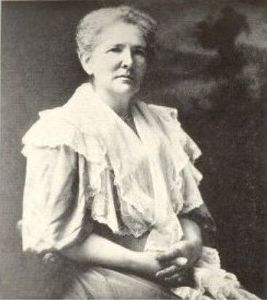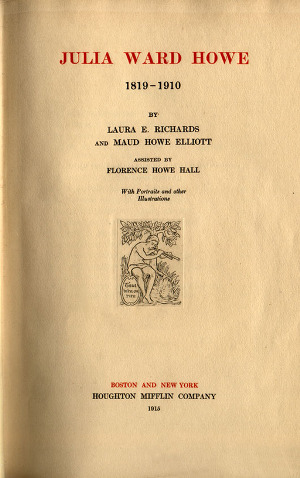Об авторе
Laura Elizabeth Howe Richards was born February 27, 1850, at 74 Mount Vernon Street, Boston, Massachusetts, to distinguished parents and a home life that would early introduce her to the delights of language and fine arts as well as to a range of people and experiences. Her father, Samuel Gridley Howe, a restless social reformer who later gained fame as an abolitionist, was also the practical founder of the Perkins Institution and Massachusetts School for the Blind in 1832. Howe’s star pupil – and Laura’s namesake – was Laura Bridgman, a child who had been left blind and deaf after a bout with scarlet fever at age two. When Bridgman was seven, Howe met her and brought her to Perkins, where she became the first blind and deaf person to learn language and “finger spell.” (Another Perkins student, Anne Sullivan, later taught Helen Keller.) Richards’s mother, the poet Julia Ward Howe, is perhaps best known as the author of “Battle Hymn of the Republic.” Laura was the youngest of four children: Julia, Florence (named for her godmother, Florence Nightingale), and Henry. A fifth child, Maud, was born a few years later, and a sixth, Sam, (who died of diphtheria at age three), several years after.
The family moved to various homes in and around Boston during Richards’s childhood. Among them were Green Peace, a house on five acres of land, and the Perkins Institution, where Howe, as Director, had one wing for the family’s use.
When still quite young, Richards was introduced to languages through her mother’s love of music.
Richards grew up surrounded by books. Among the works she recalled reading as a child were Grimms’ and Andersen’s fairy tales, Ruskin’s
King of the Golden River, Thackeray’s
The Rose and the Ring, Alcott’s
Flower Fables, Catherine Sinclair’s
Holiday House, Irving’s
Tales of the Alhambra, Wolfert’s Roost, and
Sketch-Book, and Hawthorne’s
Wonder Book, Tanglewood Tales, Twice-Told Tales, and
Mosses from an Old Manse(remarking of the latter two “These I read over and over, till I knew them almost by heart”). She also read lighter fare --
The London Doll,
The Country Doll,
Tales from Catland, and various adventure tales by Mayne Reid.
She was also familiar with the works of Scott and Dickens, noting “they, with the Bible and Shakespeare, seem in memory a kind of foundation for everything else.” None too surprisingly, she also loved poetry, or, as she expressed it “I would rather read poetry than eat my dinner any day. It has been so all my life.” She read Coventry Patmore’s
Children’s Garland and
Thalatta, as well as Elizabeth Barrett Browning, Whittier, and Tennyson; at about thirteen, she began reading Shelley and Coleridge, and, later, Robert Browning, Rosetti, and Shelley.
About 1863, the family moved to 19 Boylston Place, next door to the Richards family, whose youngest son, Henry, would later become Laura’s husband. Although she had seen Henry at dancing school, the pair had not actually spoken; the situation changed some time after the move. As one source describes it, “The most memorable early contact with the family next door came when the Richards brothers helped extinguish a fire in the Howe house. [Her sister] Maud recalls Laura, flying down the stair to answer the violent ringing of the doorbell, ‘her long, dark hair, a dusky veil, hanging about her.’ She opened the door to find the five Richards brothers. From George in evening dress, ‘I beg your pardon! Have you a fire here?’ Politely from Laura, ‘Yes, won't you come in?’” She and Henry passed each other on the stairs carrying out possessions.
At seventeen, Richards accompanied her parents and sister Julia to Europe, visiting London, Rome, Venice, Athens, and Antwerp. In the winter of 1869, she became engaged to Henry Richards, by then a Harvard classmate of her brother’s. They were married on June 17, 1871, the year he graduated from Harvard. The pair honeymooned in Europe, first stopping in England to see Richards’ family, then travelling to Bruges, Ghent, Antwerp, Nuremberg, Innsbruck, Venice, Naples, Florence, Rome, Athens, Constantinople, and Milan.
After their sojourn in Europe, the Richards returned to Green Peace, living there with Laura’s parents and younger sister. Children and books came quickly. As Richards explained, “Four years saw the birth of the first three of my seven children, Alice, Rosalind, and Henry… I had always rhymed easily; now, with the coming of the babies, and the consequent weeks and months of quiet, came a prodigious welling up of rhymes, mostly bringing their tunes ... with them. I wrote, and sang, and wrote, and could not stop. The first baby was plump and placid, with a broad, smooth back which made an excellent writing desk. She lay on her front, across my lap; I wrote on her back, the writing pad quite as steady as the writing of jingles required.” A number of those early rhymes, with illustrations by John Ames Mitchell, were then published in
St. Nicholas.
During an economic downturn in the 1870s, her husband’s business floundered. Henry’s brother, Frank Richards, offered him a management position in the Richards’s family’s paper mill, and, in the summer of 1876, Laura and Henry Richards and their three children moved to Gardiner, Maine. They lived with various members of Henry’s family for a time, then found “a square ‘Colonial’ house, with ell and barn, large chimneys, an open fireplace in every room, and even more important, an acre of lawn and garden.” Here, in the Yellow House (apparently so-named because the Richards soon replaced the brown exterior with yellow, a “warm, friendly pumpkin-color”, four additional children were born: Henry, Julia Ward, Maud (who died circa 1885), and Laura Elizabeth II.
Richards’s first book,
Five Little Mice in a Mouse Trap was published in 1880, as was
The Little Tyrant; two additional titles,
Our Baby’s Favoriteand
Sketches and Scraps (the latter illustrated by her husband), appeared the following year. The same decade saw additional publications, including retellings of folktales such as
Beauty and the Beast and
Hop o’ My Thumb (both 1886), and both volumes about Toto (
The Joyous Story of Toto [1885] and
Toto's Merry Winter [1887]). 1889 produced
Queen Hildegarde, which Richards described as “my first stumbling essay in books for girls”. This became the first of her Hildegarde series.
The 1890s brought more girls books, including
Captain January, perhaps now best known from the 1936 Shirley Temple movie. She also published several interrelated stories:
Melody (1893),
Marie (1894),
Bethsada Pool (1895),
Rosin the Beau (1898).
During the 1890s, Richards also added more volumes to the Hildegarde series, which she concluded with
Hildegarde’s Harvest in 1897, the same year she began the Margaret series, which continued into the next decade.
In 1904, the Hildegarde and Margaret series were linked with the publication of
The Merryweathers, which incorporated characters from both series. Although the two series are little known now (and Richards says little of them in her autobiography beyond the comments above and a mention that the Richards’ Camp Merryweather was named after the book, not the reverse), both series were popular in their time and are fondly remembered by several early historians of children's literature.
While Richards was turning out books, her husband’s family was struggling with the paper mill and the effects of technological change. As she explained, “By 1884 it became evident that if the Richards Paper Company were to live, its nature and its habitat must be changed. A pulp mill was built on the Kennebec at South Gardiner … and here the new industry – new in this country; our mill being the first to introduce it – was vigorously carried on. Sulphite pulp took the place of rags; instead of the long, echoing sheds, and the vats and ‘rolls,’ came ‘digesters,’ huge iron containers in which the spruce logs, carefully selected, were ‘cooked’ to pulp.” Disaster struck in 1893, when on a winter's night, the pulp mill burned to the ground. Although it was rebuilt, the paper-making world was changing like the shifts of a kaleidoscope, the great combination companies relentlessly strangling the small ones, until, in 1900, the mill finally closed.
After some thought, the Richards family considered opening a small private school. Asked his advice, their friend, Reverend Endicott Peabody of Groton School, instead suggested a camp for boys. There was a strip of forest bordering on Belgrade Great Pond, which the owner was persuaded to sell. Camp Merryweather (so named because in the Hildegarde and Margaret books, the Merryweather family spent their summers “at a Camp somewhat resembling the one at Cobbossee”) opened 30 June 1900, and was still in operation 30 years later when Richards wrote her autobiography.
Richards was also active in designing activities for youth and in community affairs in Gardiner. In 1886, she created the Howe Club (named for her father), for her ten-year-old son Hal and his friends. The group met for ninety minutes on Saturday evenings. As Richards described it, “I read to them – first a poem, then Scott or Dickens for half the time; then there were apples – or peanuts – and games in many varieties, all with the pill of Information heavily sugar-coated. To give the boys something that school in its crowded curriculum could not give; to enlarge first their vocabulary and then their horizon; to show them the fair face of poetry; first and last to give them a
good time; this was my ardent desire.”
The Howe Club lasted for approximately 25 years. Additionally, Richards was involved in founding the Ten Times One Club (afterschool activities for children) and the Good Comrades Club (for young girls in the workforce). Her interest in lifelong education led to her involvement with the History Class (later the Current Events club); this was an adult study group, where she and her husband studied with ardor, wrote their papers with passion and read them before a neighborly, friendly audience.
In 1895, she helped found the Women’s Philanthropic Union (designed to correlate the activities of various women’s organizations to avoid duplication of effort) and served as its president until 1921. She and her husband also were two of the founders of the Gardiner Library Association and participated in assorted fundraising activities for a library building, which her husband designed.
In the twentieth century, Richards continued to write children’s stories and verse, including the two-volume Honor Bright series (
Honor Bright: A Story for Girls [1920] and
Honor Bright’s New Adventure [1925]), and an unsuccessful sequel to
Captain January (
Star Bright [1927]). Her best-known collection of verse was
Tirra Lirra: New Rhymes and Old from 1932 (reissued in 1955 with a preface by May Hill Arbuthot), which incorporated early verses, many of which had been published in children’s magazines, along with new material. During this period, Richards also wrote biographies, some of family members or friends, including
Florence Nightingale: Angel of the Crimea (1909),
Two Noble Lives: Samuel Gridley Howe and Julia Ward Howe (1911), and
Laura Bridgman: The Story of an Opened Door (1928). Richards and her sister Maud Howe Elliott co-authored
Julia Ward Howe, 1819-1910 (1915), for which they received the Pulitzer Prize for biography in 1917. Her final book,
What Shall the Children Read, was published in 1939; the following year, the Gardiner Public Library Association issued
Laura E. Richards and Gardiner, a compilation of Richards’ poems and articles which had been previously published in local newspapers.
Richards died on 14 January 1943.


Комментарии и оценки к книгам автора